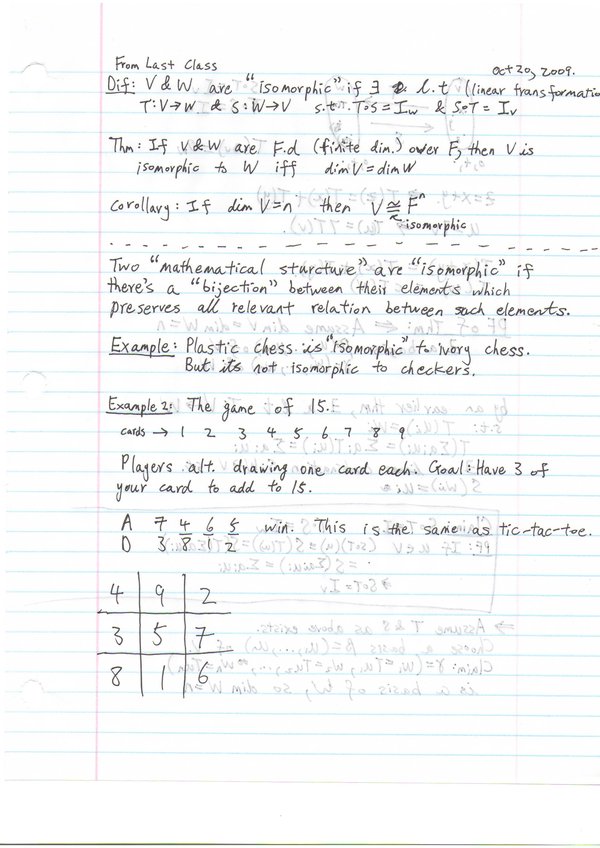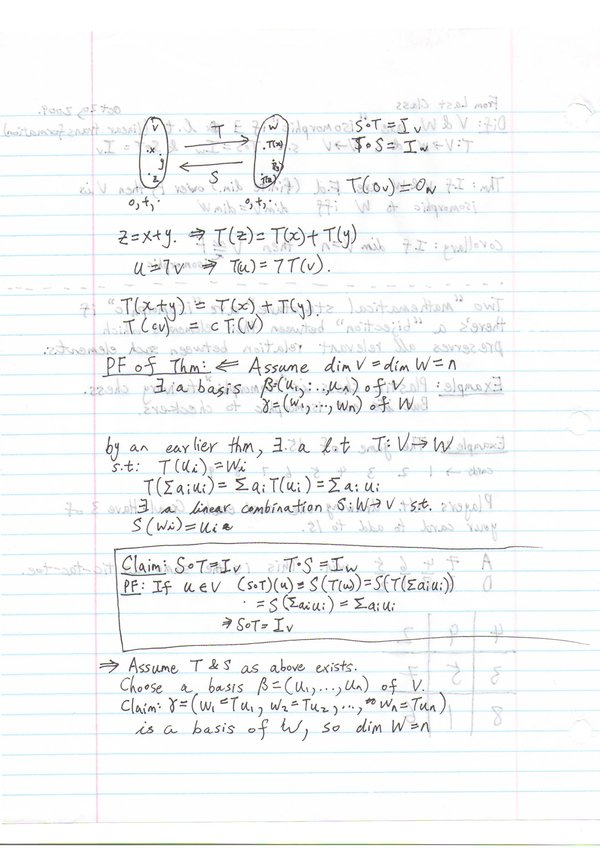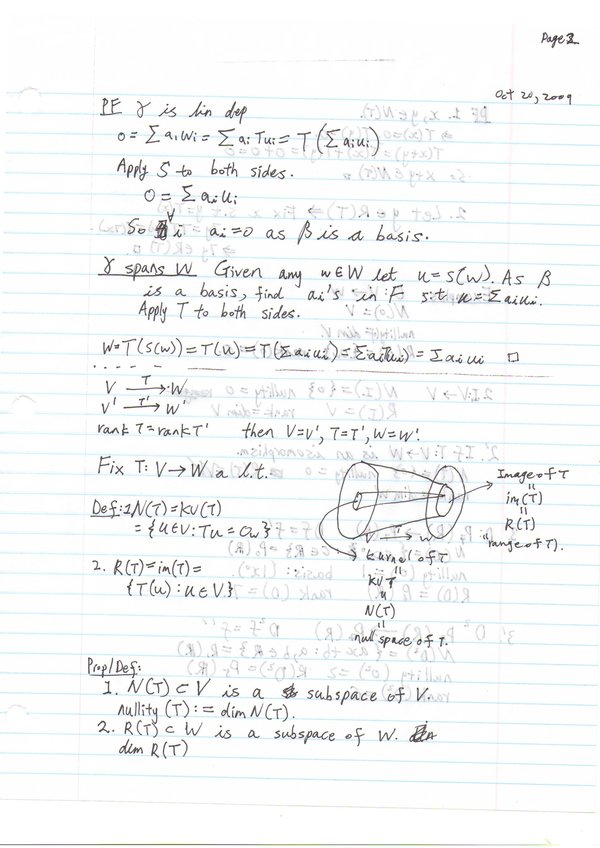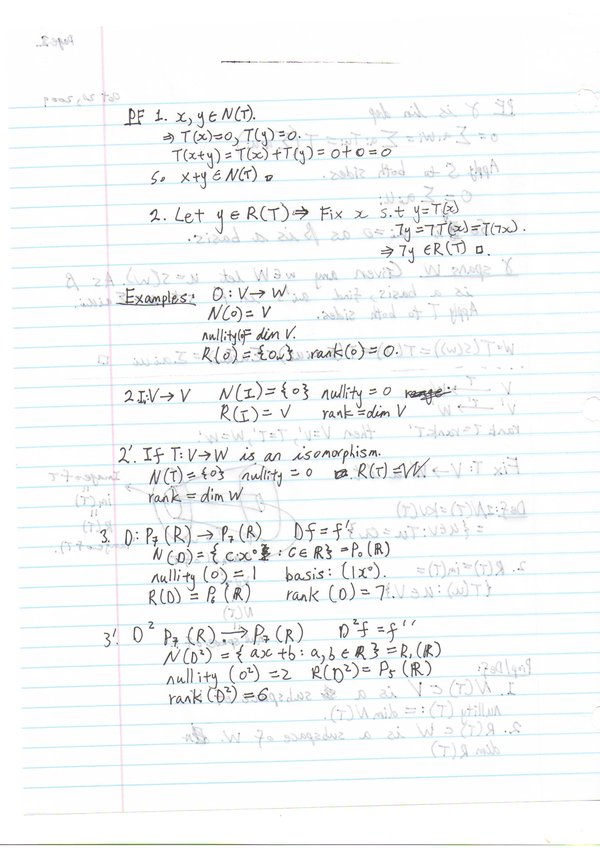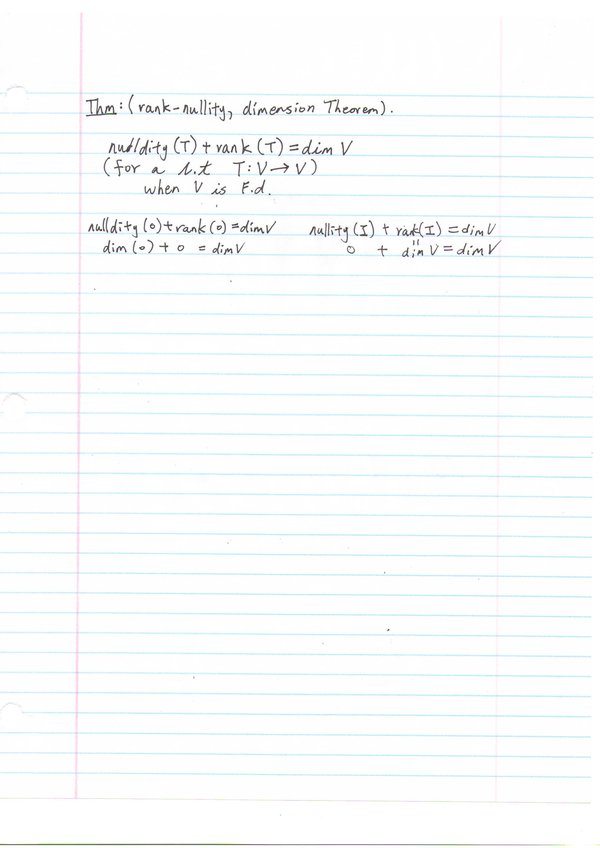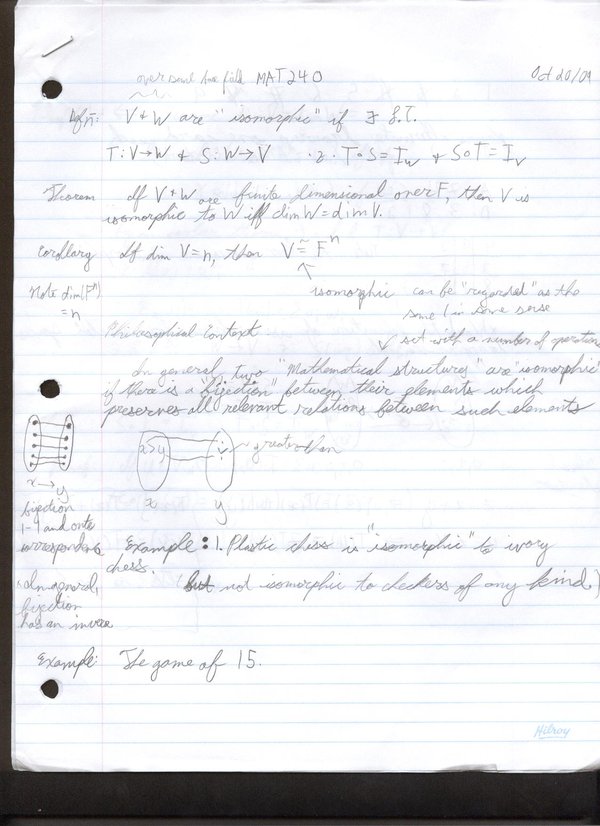09-240/Classnotes for Tuesday October 20: Difference between revisions
No edit summary |
No edit summary |
||
| Line 196: | Line 196: | ||
[[Image:Oct 20 Lecture Notes Page 4.JPG|600px]] |
[[Image:Oct 20 Lecture Notes Page 4.JPG|600px]] |
||
[[Image:Oct 20 Lecture Notes Page 5.JPG|600px]] |
[[Image:Oct 20 Lecture Notes Page 5.JPG|600px]] |
||
[[Image:Oct20note1.jpg|600px]] |
|||
Revision as of 09:49, 14 December 2009
| ||||||||||||||||||||||||||||||||||||||||||||||||||||||||||||||||||
Definition: V and W are "isomorphic" if there exist linear transformations and such that and
Theorem: If V and W are finite-dimensional over F, then V is isomorphic to W iff dim(V) = dim(W)
Corollary: If dim(V) = n then
- Note: represents "is isomorphic to"
Two "mathematical structures" are "isomorphic" if there exists a "bijection" between their elements which preserves all relevant relations between such elements.
Example: Plastic chess is "isomorphic" to ivory chess, but it is not isomorphic to checkers.
Example: The game of 15. Players alternate drawing one card each.
Goal: To have exactly three of your cards add to 15.
Sample game:
- X picks 3
- O picks 7
- X picks 8
- O picks 4
- X picks 1
- O picks 6
- X picks 2
- O picks 5
- 4 + 6 + 5 = 15. O wins.
This game is isomorphic to Tic Tac Toe!
| 4 | 9 | 2 |
| 3 | 5 | 7 |
| 8 | 1 | 6 |
- X: 3, 8, 1, 2
- O: 7, 4, 6, 5 -- Wins!
Converts to:
| O | 9 | X |
| X | O | O |
| X | X | O |
- Likewise for
Proof of Theorem Assume dim(V) = dim(W) = n
- There exists basis
- by an earlier theorem, there exists a l.t. such that
There exists a l.t. such that
Claim
Proof
If u∈ unto U=∑aiui
- (S∘T)(u)=S(T(u))=S(T(∑aiui))
- =S(∑aiwi)=∑aiui=u
- ⇒S∘T=Iv...
- ⇒Assume T&S as above exist
- Choose a basis β= (U1...Un) of V
Claim
α=(W1=Tu1, W2=Tu2, ..., Wn=Tun)
- is a basis of W, so dim W=n
Proof
α is lin. indep.
- T(0)=0=∑aiwi=∑aiTui=T(∑aiui)
- Apply S to both sides:
- 0=∑aiui
- So ∃iai=0 as β is a basis
α Spans W
- Given any w∈W let u=S(W)
- As β is a basis find ais in F s.t. v=∑aiui
Apply T to both sides: T(S(W))=T(u)=T(∑aiui)=∑aiT(ui)=∑aiWi
- ∴ I win!!! (QED)
- T T
- V → W ⇔ V' → W'
- rank T=rank T'
Fix t:V→Wa l.t.
Definition
- N(T) = ker(T) = {u∈V : Tu = 0W}
- R(T) = im(T) = {T(u) : u∈V}
Prop/Def
- N(T) ⊂ V is a subspace of V-------nullity(T) := dim N(T)
- R(T) ⊂ W is a subspace of W--------rank(T) := dim R(T)
Proof 1
- x,y ∈N(T)⇒T(x)=0, T(y)=0
- T(x+y)=T9x)+T(y)=0+0=0
- x+y∈N(T)
- ∴ I win!!! (QED)
Proof 2
- Let y∈R(T)⇒fix x s.t y=T(x),
- --------7y=7T(x)=T(7x)
- ----------⇒7y∈R(T)
- ∴ I win!!! (QED)
Examples
1.
- 0:V→W---------N(0)=V
- R(0)={0W}-----------nullity(0)=dim V
- --------------rank(0)=0
- dim V+0=dimV
2.
- IV:V→V
- N(I)={0}
- nullity=0
- R(I)=dim V
- 2'If T:V→W is an imorphism
- N(T)={0}
- nullity =0
- R(T)=W
- rank=dim W
- 0+dim V=dim V
3.
- D:P7(R)→P7(R)
- Df=f'
- N(D)={C⊃C°: C∈R}=P0(R)
- R(D)⊂P6(R)
- nullity(D)=1
- basis:(1x°)
- rank(D)=7
- 7+1=8
4.
- 3':D2:P7(R)
- D2f=f
- W(D2)={ax+b: a,b∈R}=P1(R)
- nullity(D2)=2
- R(D2)=P5(R)
- rank (D2)=6
- 6+2=8
Theorem
(rank-nullity Theorem, a.k.a. dimension Theorem)
- nullity(T)+rank(T)=dim V
- (for a l.t. T:V→W) when V is F.d.
Proof
(To be continued next day)





















